Abstract
Retinitis pigmentosa (RP) is the name given to a heterogeneous group of retinal degenerations mapping to at least 16 loci. The autosomal dominant form (ARP), accounting for approximately 25% of cases, can be caused by mutations in two genes, rhodopsin and peripherin/RDS, and by at least six other loci identified by linkage analysis. The RP11 locus for adRP has previously been mapped to chromosome 19q13.4 in a large English family. This linkage has been independently confirmed in a Japanese family, and we now report three additional unrelated linked U.K. families, suggesting that this is a major locus for RP. Linkage analysis in the U.K. families refines the RP11 interval to 5 cM between markers D19S180 and AFMc001yb1. All linked families exhibit incomplete penetrance; some obligate gene carriers remain asymptomatic throughout their lives, whereas symptomatic individuals experience night blindness and visual field loss in their teens and are generally registered as blind by their 30s. This "bimodal expressivity" contrasts with the variable-expressivity RP mapping to chromosome 7p (RP9) in another family, which has implications for diagnosis and counseling of RP11 families. These results may also imply that a proportion of sporadic RP, previously assumed to be recessive, might result from mutations at this locus.
Full text
PDF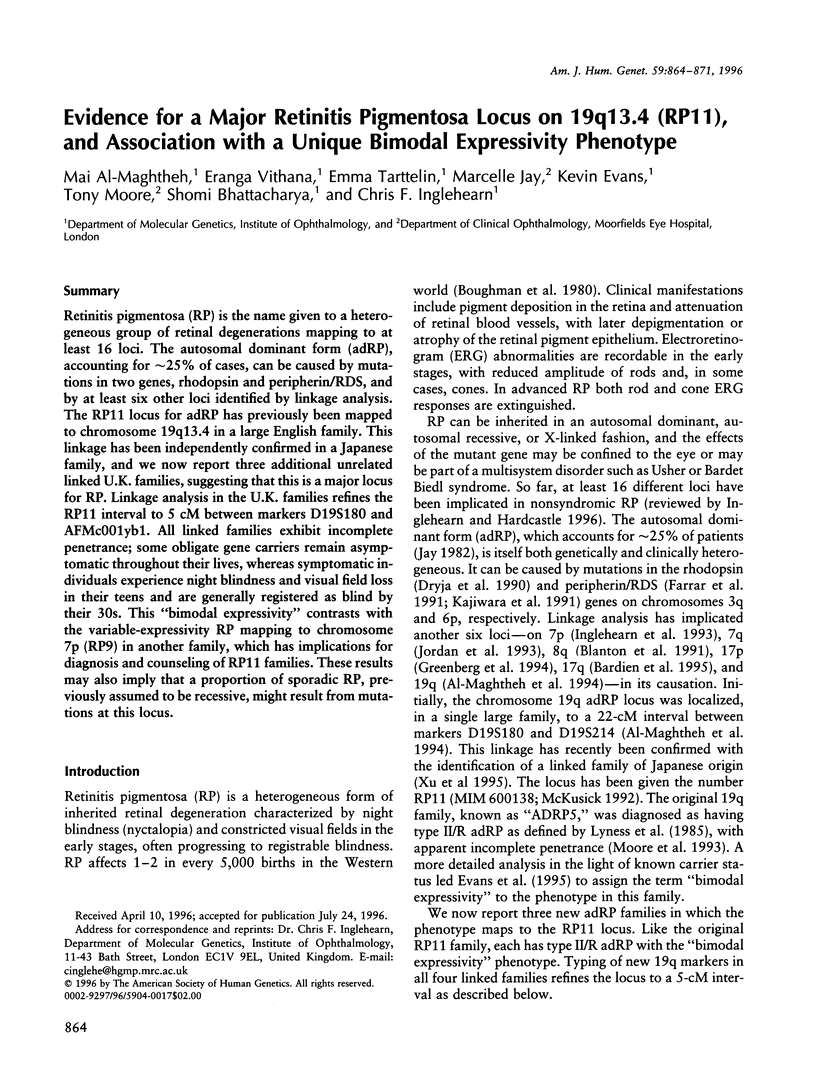
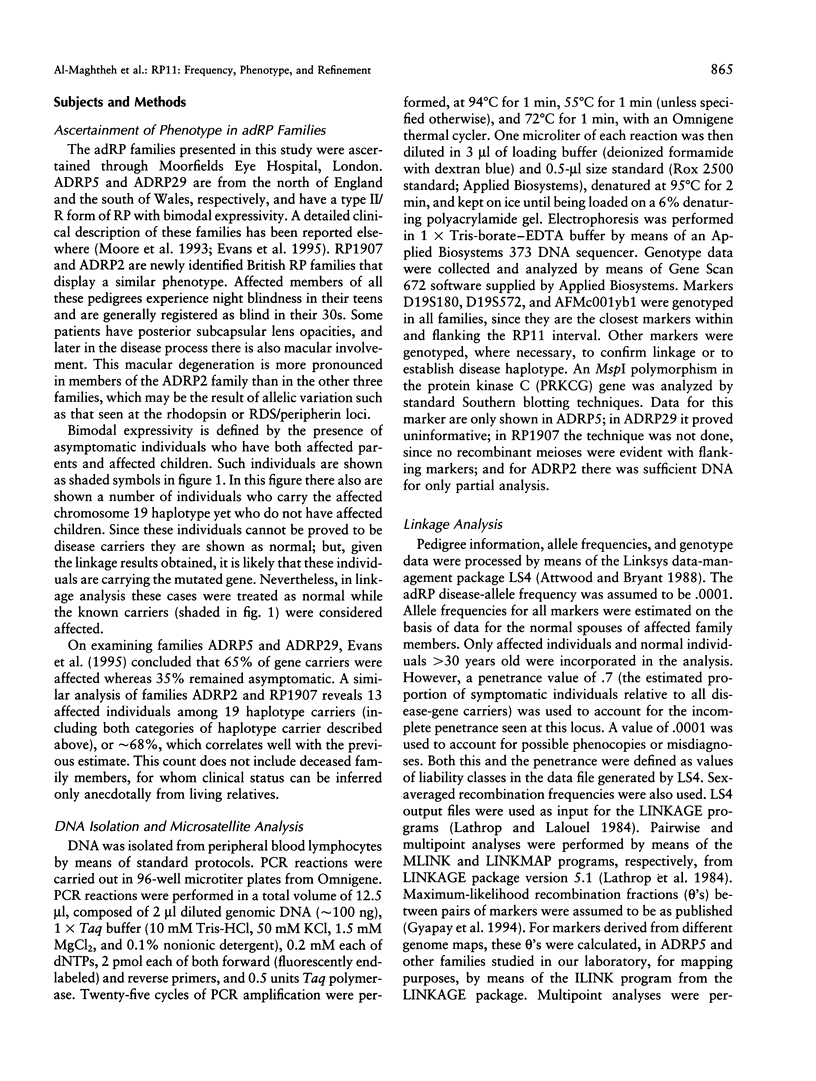
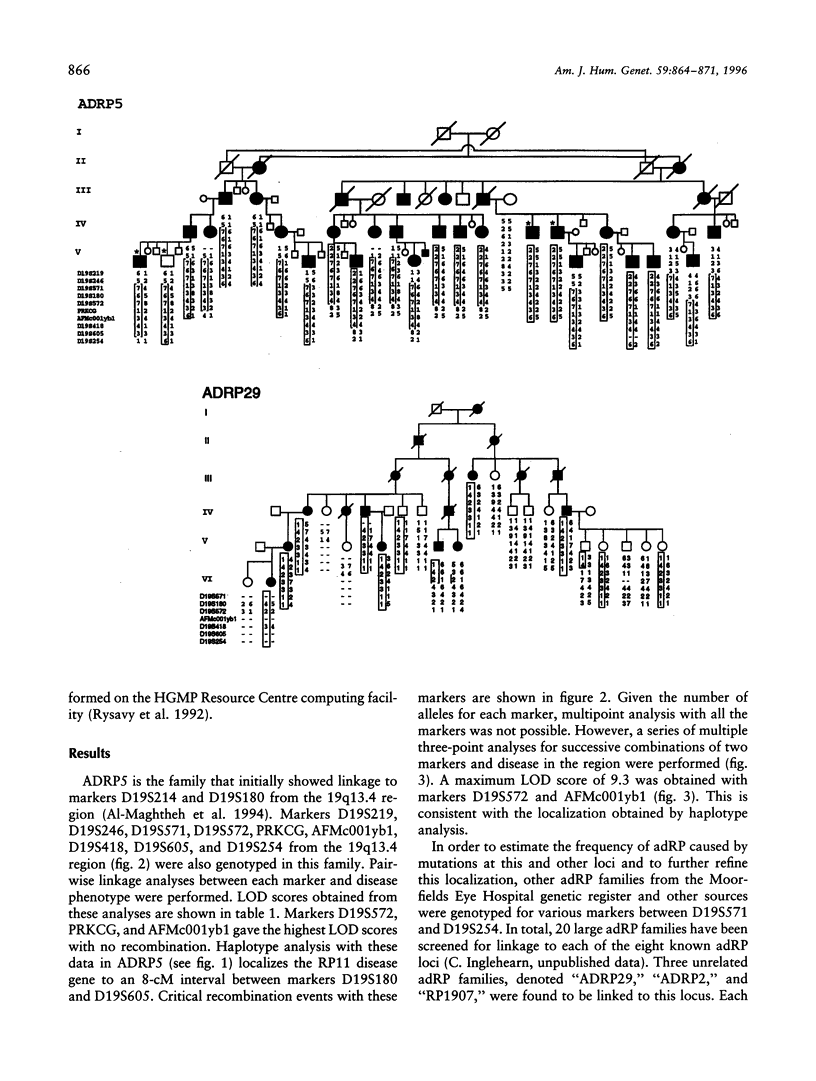
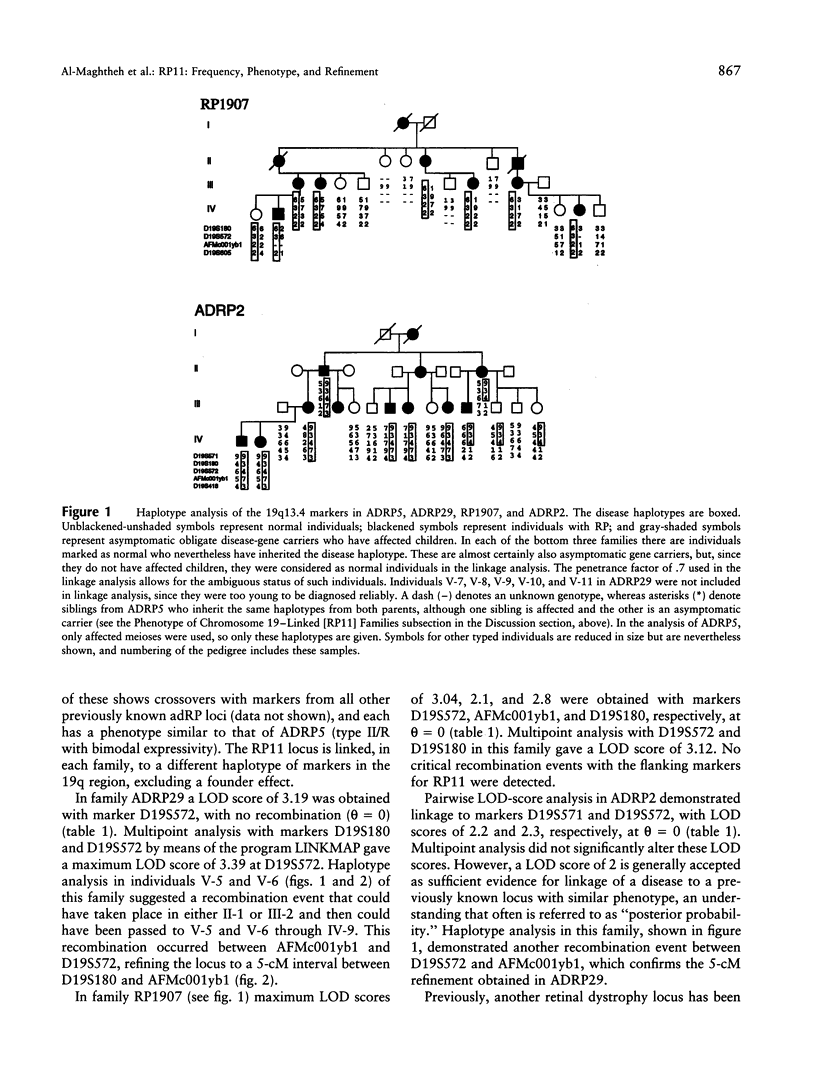
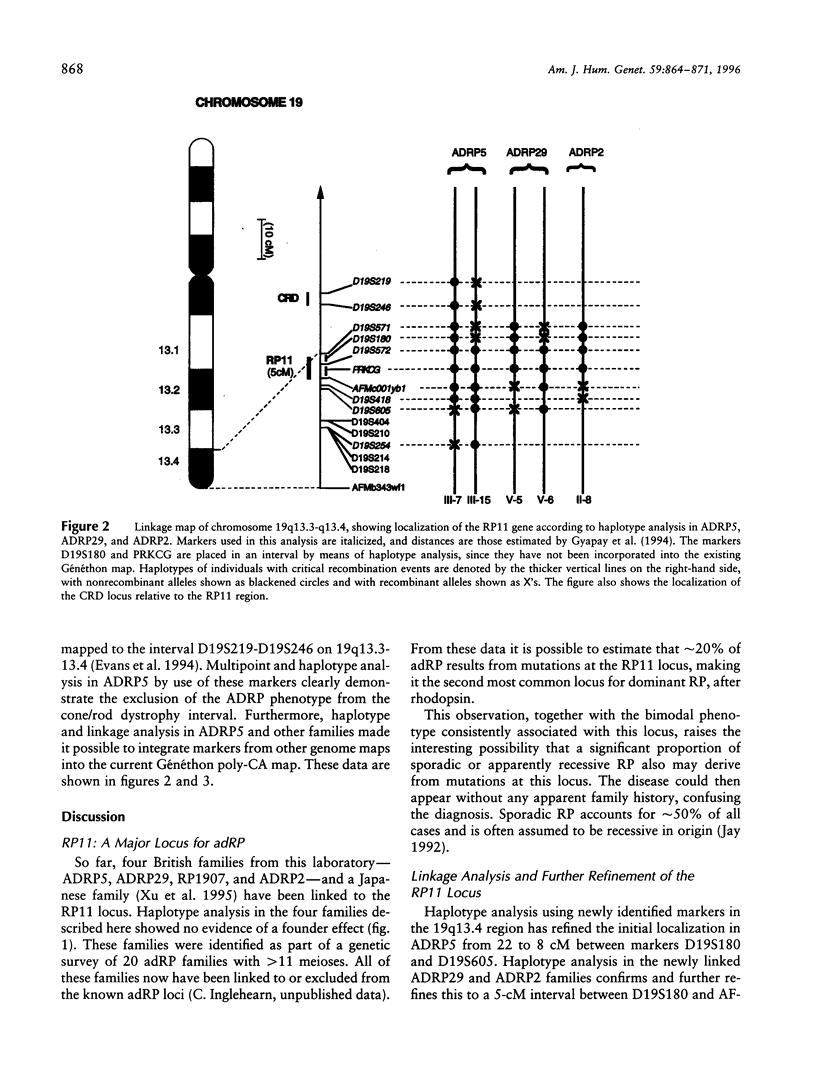
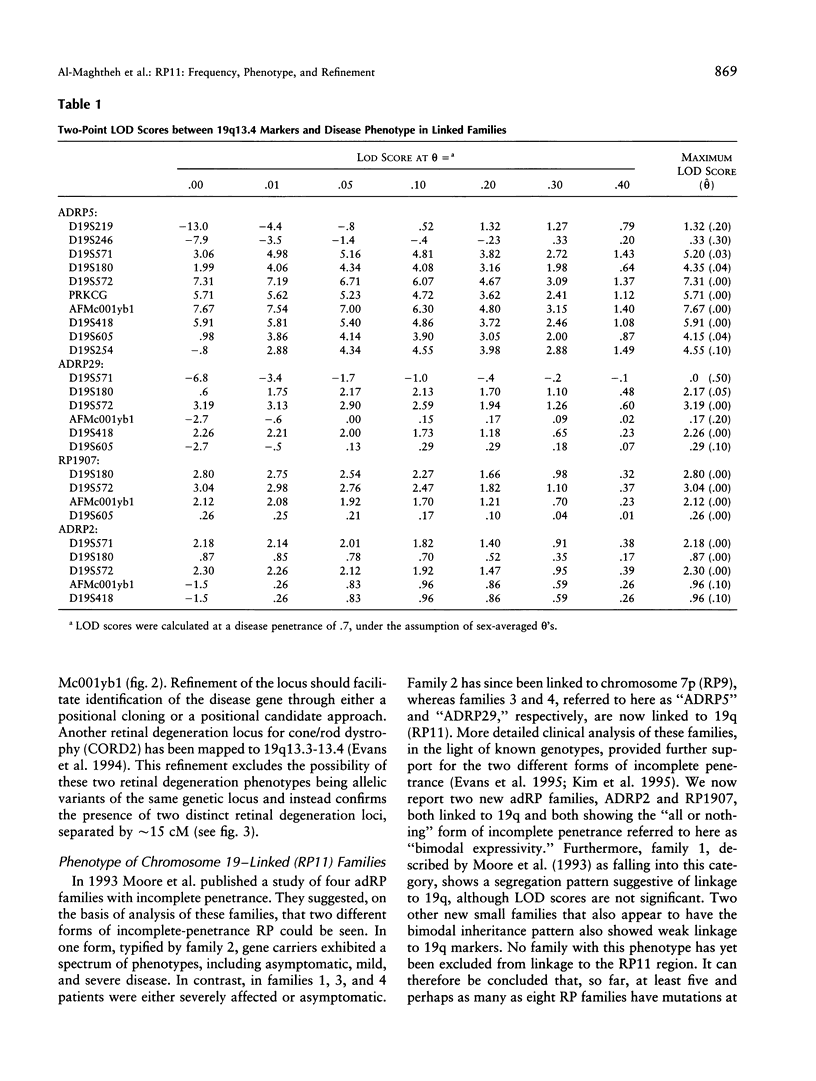
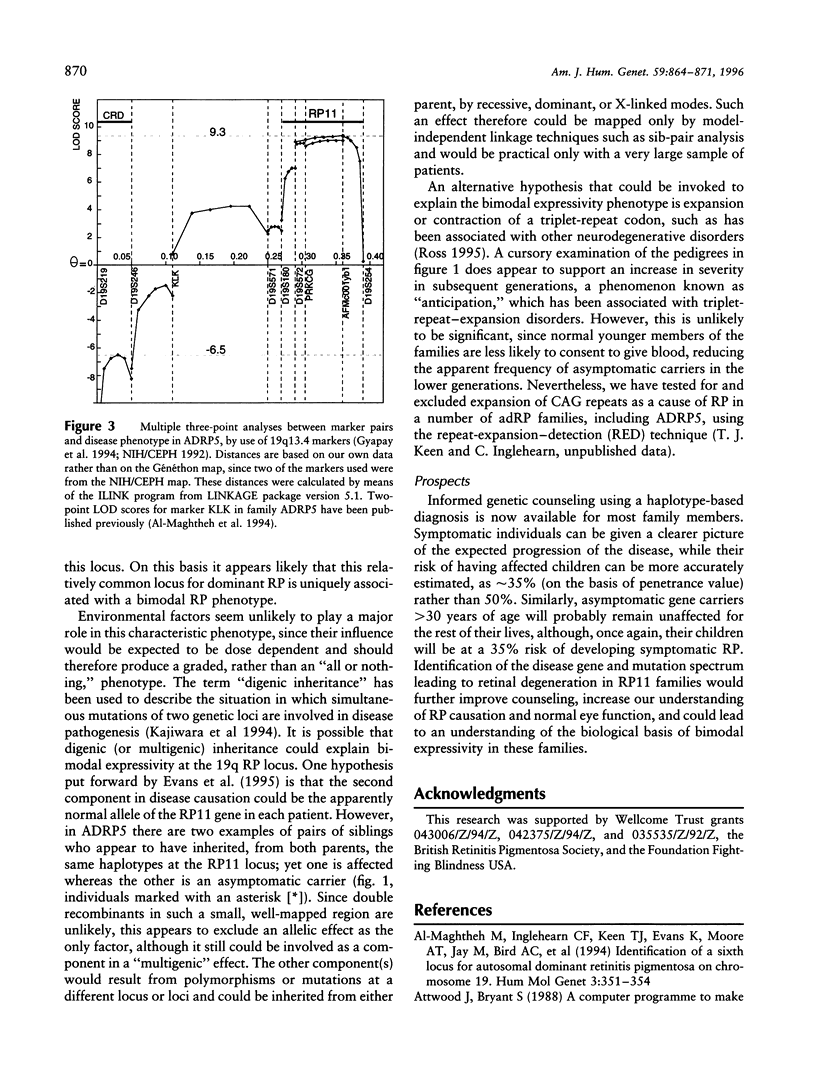
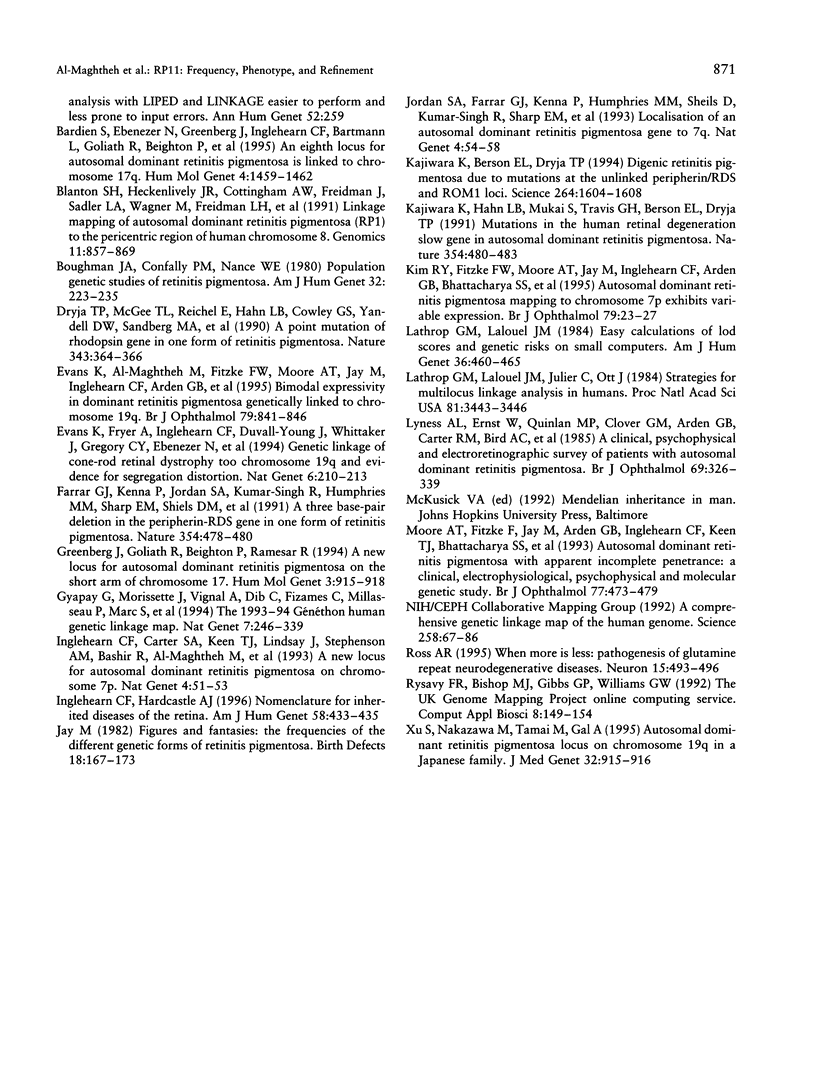
Selected References
These references are in PubMed. This may not be the complete list of references from this article.
- Attwood J., Bryant S. A computer program to make linkage analysis with LIPED and LINKAGE easier to perform and less prone to input errors. Ann Hum Genet. 1988 Jul;52(Pt 3):259–259. doi: 10.1111/j.1469-1809.1988.tb01103.x. [DOI] [PubMed] [Google Scholar]
- Bardien S., Ebenezer N., Greenberg J., Inglehearn C. F., Bartmann L., Goliath R., Beighton P., Ramesar R., Bhattacharya S. S. An eighth locus for autosomal dominant retinitis pigmentosa is linked to chromosome 17q. Hum Mol Genet. 1995 Aug;4(8):1459–1462. doi: 10.1093/hmg/4.8.1459. [DOI] [PubMed] [Google Scholar]
- Blanton S. H., Heckenlively J. R., Cottingham A. W., Friedman J., Sadler L. A., Wagner M., Friedman L. H., Daiger S. P. Linkage mapping of autosomal dominant retinitis pigmentosa (RP1) to the pericentric region of human chromosome 8. Genomics. 1991 Dec;11(4):857–869. doi: 10.1016/0888-7543(91)90008-3. [DOI] [PubMed] [Google Scholar]
- Boughman J. A., Conneally P. M., Nance W. E. Population genetic studies of retinitis pigmentosa. Am J Hum Genet. 1980 Mar;32(2):223–235. [PMC free article] [PubMed] [Google Scholar]
- Dryja T. P., McGee T. L., Reichel E., Hahn L. B., Cowley G. S., Yandell D. W., Sandberg M. A., Berson E. L. A point mutation of the rhodopsin gene in one form of retinitis pigmentosa. Nature. 1990 Jan 25;343(6256):364–366. doi: 10.1038/343364a0. [DOI] [PubMed] [Google Scholar]
- Evans K., Fryer A., Inglehearn C., Duvall-Young J., Whittaker J. L., Gregory C. Y., Butler R., Ebenezer N., Hunt D. M., Bhattacharya S. Genetic linkage of cone-rod retinal dystrophy to chromosome 19q and evidence for segregation distortion. Nat Genet. 1994 Feb;6(2):210–213. doi: 10.1038/ng0294-210. [DOI] [PubMed] [Google Scholar]
- Evans K., al-Maghtheh M., Fitzke F. W., Moore A. T., Jay M., Inglehearn C. F., Arden G. B., Bird A. C. Bimodal expressivity in dominant retinitis pigmentosa genetically linked to chromosome 19q. Br J Ophthalmol. 1995 Sep;79(9):841–846. doi: 10.1136/bjo.79.9.841. [DOI] [PMC free article] [PubMed] [Google Scholar]
- Farrar G. J., Kenna P., Jordan S. A., Kumar-Singh R., Humphries M. M., Sharp E. M., Sheils D. M., Humphries P. A three-base-pair deletion in the peripherin-RDS gene in one form of retinitis pigmentosa. Nature. 1991 Dec 12;354(6353):478–480. doi: 10.1038/354478a0. [DOI] [PubMed] [Google Scholar]
- Greenberg J., Goliath R., Beighton P., Ramesar R. A new locus for autosomal dominant retinitis pigmentosa on the short arm of chromosome 17. Hum Mol Genet. 1994 Jun;3(6):915–918. doi: 10.1093/hmg/3.6.915. [DOI] [PubMed] [Google Scholar]
- Gyapay G., Morissette J., Vignal A., Dib C., Fizames C., Millasseau P., Marc S., Bernardi G., Lathrop M., Weissenbach J. The 1993-94 Généthon human genetic linkage map. Nat Genet. 1994 Jun;7(2 Spec No):246–339. doi: 10.1038/ng0694supp-246. [DOI] [PubMed] [Google Scholar]
- Inglehearn C. F., Carter S. A., Keen T. J., Lindsey J., Stephenson A. M., Bashir R., al-Maghtheh M., Moore A. T., Jay M., Bird A. C. A new locus for autosomal dominant retinitis pigmentosa on chromosome 7p. Nat Genet. 1993 May;4(1):51–53. doi: 10.1038/ng0593-51. [DOI] [PubMed] [Google Scholar]
- Inglehearn C. F., Hardcastle A. J. Nomenclature for inherited diseases of the retina. Am J Hum Genet. 1996 Feb;58(2):433–435. [PMC free article] [PubMed] [Google Scholar]
- Jay M. Figures and fantasies: the frequencies of the different genetic forms of retinitis pigmentosa. Birth Defects Orig Artic Ser. 1982;18(6):167–173. [PubMed] [Google Scholar]
- Jordan S. A., Farrar G. J., Kenna P., Humphries M. M., Sheils D. M., Kumar-Singh R., Sharp E. M., Soriano N., Ayuso C., Benitez J. Localization of an autosomal dominant retinitis pigmentosa gene to chromosome 7q. Nat Genet. 1993 May;4(1):54–58. doi: 10.1038/ng0593-54. [DOI] [PubMed] [Google Scholar]
- Kajiwara K., Berson E. L., Dryja T. P. Digenic retinitis pigmentosa due to mutations at the unlinked peripherin/RDS and ROM1 loci. Science. 1994 Jun 10;264(5165):1604–1608. doi: 10.1126/science.8202715. [DOI] [PubMed] [Google Scholar]
- Kajiwara K., Hahn L. B., Mukai S., Travis G. H., Berson E. L., Dryja T. P. Mutations in the human retinal degeneration slow gene in autosomal dominant retinitis pigmentosa. Nature. 1991 Dec 12;354(6353):480–483. doi: 10.1038/354480a0. [DOI] [PubMed] [Google Scholar]
- Kim R. Y., Fitzke F. W., Moore A. T., Jay M., Inglehearn C., Arden G. B., Bhattacharya S. S., Bird A. C. Autosomal dominant retinitis pigmentosa mapping to chromosome 7p exhibits variable expression. Br J Ophthalmol. 1995 Jan;79(1):23–27. doi: 10.1136/bjo.79.1.23. [DOI] [PMC free article] [PubMed] [Google Scholar]
- Lathrop G. M., Lalouel J. M. Easy calculations of lod scores and genetic risks on small computers. Am J Hum Genet. 1984 Mar;36(2):460–465. [PMC free article] [PubMed] [Google Scholar]
- Lathrop G. M., Lalouel J. M., Julier C., Ott J. Strategies for multilocus linkage analysis in humans. Proc Natl Acad Sci U S A. 1984 Jun;81(11):3443–3446. doi: 10.1073/pnas.81.11.3443. [DOI] [PMC free article] [PubMed] [Google Scholar]
- Lyness A. L., Ernst W., Quinlan M. P., Clover G. M., Arden G. B., Carter R. M., Bird A. C., Parker J. A. A clinical, psychophysical, and electroretinographic survey of patients with autosomal dominant retinitis pigmentosa. Br J Ophthalmol. 1985 May;69(5):326–339. doi: 10.1136/bjo.69.5.326. [DOI] [PMC free article] [PubMed] [Google Scholar]
- Moore A. T., Fitzke F., Jay M., Arden G. B., Inglehearn C. F., Keen T. J., Bhattacharya S. S., Bird A. C. Autosomal dominant retinitis pigmentosa with apparent incomplete penetrance: a clinical, electrophysiological, psychophysical, and molecular genetic study. Br J Ophthalmol. 1993 Aug;77(8):473–479. doi: 10.1136/bjo.77.8.473. [DOI] [PMC free article] [PubMed] [Google Scholar]
- Ross C. A. When more is less: pathogenesis of glutamine repeat neurodegenerative diseases. Neuron. 1995 Sep;15(3):493–496. doi: 10.1016/0896-6273(95)90138-8. [DOI] [PubMed] [Google Scholar]
- Rysavy F. R., Bishop M. J., Gibbs G. P., Williams G. W. The UK Human Genome Mapping Project online computing service. Comput Appl Biosci. 1992 Apr;8(2):149–154. doi: 10.1093/bioinformatics/8.2.149. [DOI] [PubMed] [Google Scholar]
- Xu S., Nakazawa M., Tamai M., Gal A. Autosomal dominant retinitis pigmentosa locus on chromosome 19q in a Japanese family. J Med Genet. 1995 Nov;32(11):915–916. doi: 10.1136/jmg.32.11.915. [DOI] [PMC free article] [PubMed] [Google Scholar]
- al-Maghtheh M., Inglehearn C. F., Keen T. J., Evans K., Moore A. T., Jay M., Bird A. C., Bhattacharya S. S. Identification of a sixth locus for autosomal dominant retinitis pigmentosa on chromosome 19. Hum Mol Genet. 1994 Feb;3(2):351–354. doi: 10.1093/hmg/3.2.351. [DOI] [PubMed] [Google Scholar]


